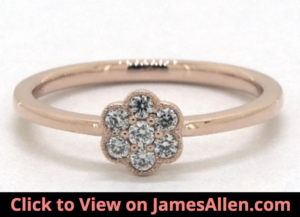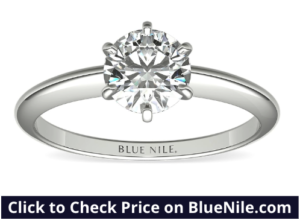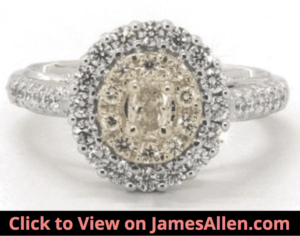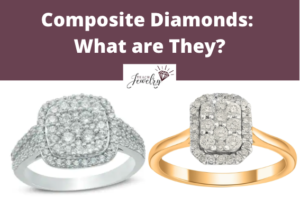
Many pieces of jewelry come with a serious price tag, but there are diamond rings that still command attention while offering a discount compared to their solitaire counterparts.
One popular choice is a composite diamond ring.
We’ll explore everything to know about composite diamonds, including:
- Pros and cons
- Buying tips
- How to maintain them
- How to decide if it’s right for you
Let’s dive into the details on each.
What is a Composite Diamond Ring?
Composite diamonds rings feature multiple small diamonds placed together to create the look of a larger diamond. In some cases, the stones are tightly pressed against each other to mimic the appearance of one diamond and in other cases are designed to enhance its brilliance.
Check out the composite diamond below, which also includes pavé lining the shank.
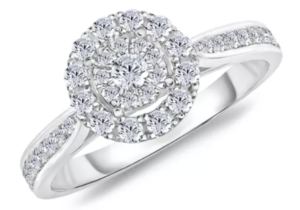
Its total carat weight (CTTW) is one-third of a carat. So with 40 total diamond on the piece, each weighs less than 0.01 carats.
The ones clustered together in the middle are what result in the composite diamond ring. Unless you view it closely, could appear as a single gem.
Like the example above, many composite diamond rings include more than three stones. But when two diamonds are fused together, it’s called a doublet. When it’s three, it’s a triplet.
Each type offers a distinct style from a traditional diamond ring, which is a solitaire setting with one center stone.
Composite diamonds are considered a vintage look and aren’t often used for engagement rings.
Are Composite Diamonds Real?
Composite diamonds can be made up of real diamonds or simulants such as moissanite, cubic zirconia, or lab-created diamonds. It’s not the way diamonds are set on top of the shank that determine whether they’re real.
You can have a composite diamond that features only natural diamonds, or one with a combination of real diamonds and simulants. Most include only one or the other.
Without special equipment, it’s impossible to tell whether a diamond is real or fake. So purchase from a trusted vendor, or if you’re unsure, you’ll need a diamond tester or gemologist to verify its authenticity.
The value of lab-grown diamonds and simulants is far less than an earth-mined diamond, so it’s critical you don’t purchase the former under the assumption it’s the later.
Pros of Composite Diamonds
Affordability Compared to Larger Diamonds
The primary appeal of composite diamonds is they’re more affordable. As diamonds move up in carat weight, they become disproportionately more expensive.
A two-carat diamond doesn’t cost twice as much as a one carat diamond. Instead, expect to pay four or five times as much for twice the carat weight.
For example, this two-carat diamond $27,300. This 0.50-carat diamond that has the same clarity, cut, and color costs $1,500.
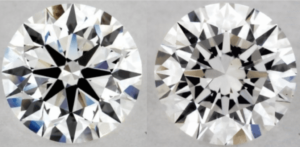
To further demonstrate this concept, I analyzed prices for diamonds beginning at one-carat up through four carats and determined the average price at intervals of 0.5.
Here’s the graph showing the results.
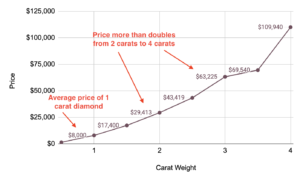
This leads many buyers to opt for multiple smaller diamonds instead of a larger one.
Instead of paying $25,000-$30,000 for a quality two-carat diamond, you could buy four 0.50-carat diamonds for about $1,500 each.
Your total cost would equal $6,000 for a total carat weight of two, instead of more than $25,000 for one diamond with the same carat weight.
Imitates a Larger Stone
When composite diamonds are the same color and bound tightly together, it imitates the appearance of a larger stone.
At a quick glance or from a distance, it wouldn’t be noticeable the piece actually features multiple diamonds.
Here’s an example of that type of ring.
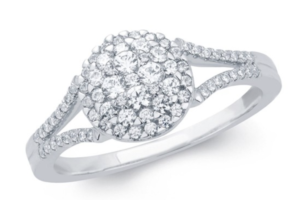
All the diamonds are colorless with close to the same clarity grades. There’s little space between them, and it forms a round shape.
If you desire the appearance of a big diamond but don’t have the budget to pay for it, composite diamonds offer the best of both worlds by imitating a single stunning center gem without the price tag that comes along with it.
Holds Many Types of Gems
Composite diamond rings don’t have to be filled with only natural diamonds. Another advantage is the ability to use other types of gems such as moissanite, cubic zirconia, or other diamond simulants.
To illustrate, here’s one that features rubies at its center.
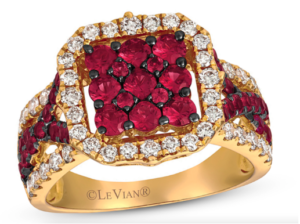
Thirteen rubies are placed closely together. Nine are one size and the other four also match. Colorless diamonds surround them and line the shank, which has more rubies.
This composite ring is made with lab-created moissanite.
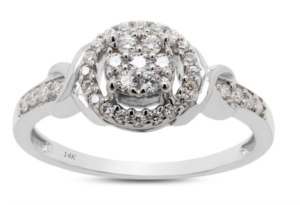
The gems imitate the appearance of a diamond but cost less.
But if you’re tight on budget and still want diamonds in the middle, I recommend lab-grown ones.
They often cost 50 percent less than natural diamonds but have the same chemical and physical properties.
Variety of Designs
The classic composite design is two or three colorless diamonds on one piece.
But because you’re dealing with multiple diamonds, there are a variety of designs available that include unique colors and placement of diamonds.
For example, this golden blossoms diamond ring features seven round-cut diamonds in a floral pattern.
Check out the piece on the vendor’s website, and rotate it 360 degrees to learn how to appears at each angle.
The goal of the design isn’t to mimic the aesthetic of one diamond but instead is distinguished by its shape and the milgrain surrounding the diamonds.
You can also find instances where the main gem is a different color from the smaller surrounding ones. One popular style is a colored center gem, such as yellow, placed between colorless diamonds.
For example, there are princess-cut sapphires in the middle surrounded by round cuts and pink sapphires.
It demonstrates the variety of designs available when choosing a composite diamond ring.
Casual Wear
Composite diamonds are considered a more casual style than their solitaire counterparts. It’s one reason they aren’t as popular of a choice for engagement rings.
But you don’t have to choose between one or the other.
One way to use a composite diamond to complement another piece is to buy a style unique from your other rings.
If your engagement ring is a colorless solitaire ring, your composite diamonds could add color to your style with a champagne diamond surrounded by colorless ones.
Cons of Composite Diamonds
Costs of Repair
Consider the costs and difficulty of repairs for composite diamonds.
Most diamond rings need touch ups and cleanings over the course of their lifespan. But the uniqueness of composite diamonds can add difficulty and costs to repairs.
When creating the piece, the individual diamonds are carefully placed on the setting, often right against other small diamonds. If one falls out, it’s not easy to find an exact match diamond and then add it to the piece.
This is especially true in the case of notched diamonds within invisible settings. It takes the right sized diamond to fit within the setting.
If you can’t find the exact fit, you’ll have to pay more to have a diamond cut into the right size.
Cleaning and Maintenance
Relatedly, composite diamonds are more difficult to clean because of their number and size. All diamonds collect debris as they’re worn, so you should have your piece of jewelry cleaned at least once per year.
It’s easier for you or a jeweler to clean one center diamond than it is to clean multiple small ones. The spaces between them collect unwanted grime more easily than a solitaire ring. Removing the debris from those small areas is more challenging.
While diamond rings can be cleaned at home, a complete cleaning of your composite diamond piece may need the help of a professional.
Diminished Fire and Brilliance
Composite diamonds can be placed in a way that maximizes their light performance and resulting fire and brilliance, but compared to a single gem, it’ll likely fall short.
The larger surface area of the solitaire diamond allows it to reflect, refract, and disperse the most light.
It’s another reason why they’re the most common choice for engagement ring diamonds. They exhibit the most brilliance when it’s a large round diamond with an excellent cut, standing alone on top, like the one below.
It’s held in place by six small prongs, which maximizes the tables exposure to light.
Composite diamonds, on the other hand, are generally too small to collect and return much light.
If you opt for a composite diamond and want to improve its brilliance, choose the smallest number of diamonds with the highest corresponding carat weight.
For example, a variation with four diamonds that each weight 0.25 carats will likely display more white light than one with 10 small diamonds weighing 0.1 carats.
Ensure the diamonds have high color and clarity grades. Inclusions and tints of yellow can inhibit brilliance and fire.
Lack GIA Evaluation
Jewelers have their diamonds evaluated by organizations such as the GIA or AGS because it gives the buyer confidence in its quality.

But these evaluations cost time and money, so many jewelers won’t submit diamonds less than one carat for certification.
Composite diamonds are often small enough to not warrant certification.
The buyer can’t be certain of its color, clarity, cut, or any of the other measures used to determine a diamond’s quality.
Instead, they have to rely on the traits asserted by the jeweler and not an objective third-party.
They aren’t as significant of a purchase as larger diamonds that are certified, so there’s lower risk in overvaluing its quality.
The solution to a lack of certification is to buy from a trusted online or brick and mortar retailer and to view the diamond in person or through high-resolution images.
Don’t Retain as Much Value
I caution against buying diamonds as an investment because it’s highly unlikely you’ll sell it later for more than you paid. But many buyers do consider the resale value of a diamond, in case they opt for a different style down the road.
Don’t expect a ring with composite diamonds to retain its value as much as a single, larger diamond. In most cases, a natural diamond will retain 20 to 60 percent of its value.
If you’ve bought a composite diamond ring, your expectation shouldn’t be that high.
There’s a smaller market for these diamond rings, and each individual gem on the piece isn’t as valuable.
You may be able to find a buyer, but the resale price likely won’t be nearly as much as what you initially paid.
Buying Tips
Understand CTTW
You also should know the difference between the carat weight of a single diamond and the CTTW of the piece.
If you misunderstand this terminology, it can be costly.
As an example, let’s assume you’re exploring two composite diamond rings.
One has eight stones that are 0.1 carats each, and the other has four stones of 0.2 carats each. You might think if all other qualities are equal, they should sell for the same price because they total 0.8 carats.
You should actually pay less for the one with eight stones, because two of the 0.1 carat stones are less valuable than one of the 0.2 carat ones.
This concept is even more relevant when comparing it to a solitaire diamond. The value of a composite diamond with a CTTW of one carat is significantly less valuable than a solitaire ring with a CTTW of one, if all other qualities are equal.
Also consider the impact of diamonds lining the ring. In this fancy yellow composite diamond ring, there are 12 pave diamonds on the shank.
It increase the CTTW in an area separate from the composite diamonds in the middle.
Choose Your Preferred Design
As you’ve seen in all the examples above, there are many designs for composite diamond rings. So my recommendation is to decide the category that best fits your taste.
For example, do you want the diamonds to all be the same color? Or should the ones in the center not match surrounding ones?
Do you want a maximum of five diamonds to make up the composite piece, or are you okay with 20+ diamonds on your ring?
Do you want pavé diamonds lining the shank, or a band free of additional diamonds.
There are no right or wrong answers here, but it’s easy to be overwhelmed by the designs available.
How to Decide if a Composite Diamond is Right for You
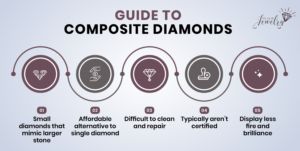
Composite diamonds are a more affordable alternative to solitaires because you can end up with the same CTTW but pay a lower price for the piece.
While cost is the primary advantage, it offers unique designs fit for casual or formal wear.
If you can’t decide whether you want colorless or colored gems, or want to explore multiple cuts on the same ring, composite diamond rings are a fitting solution.
Approach the buying process with an awareness of its downsides as well, such as potentially higher repair costs and less brilliance compared to single diamonds.
You’ll have confident in your choice of a composite diamond ring that’s affordable and displays your personal style.

Jacob Clarke
Jacob Clarke is the founder of TeachJewelry.com.
He earned an Applied Jewelry Professional Diploma from the Gemological Institute of America (GIA) and now brings you essential information about diamonds, settings, and more.
Jacob has consulted with leading jewelry brands, and his work has been cited in Clean Origin, Diamond Nexus and industry publications.
He's also a member of the International Gem Society.
He enjoys discussing jewelry with readers, so contact him with any questions at jacob.clarke@teachjewelry.com.

